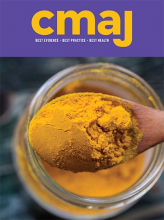Individuals with past hepatitis B virus (HBV) infection on immunosuppressive therapy are at risk of HBV reactivation
Hepatitis B virus (HBV) reactivation is defined as a shift from negative to positive hepatitis B surface antigen (HBsAg), or new HBV DNA detection or its rise compared with baseline (Supplemental Table 1, Appendix 1, available at www.cmaj.ca/lookup/suppl/doi:10.1503/cmaj.180389/-/DC1).1 Immunosuppression can result in reactivation of HBV replication inside hepatocytes, which become targeted and damaged upon immune reconstitution.2 Reactivation of HBV from chemotherapy treatment has been reported in 41%–53% of patients who are HBsAg-positive and positive for hepatitis B core antibody (HBc), and in 8%–18% of patients who are HBsAg-negative and anti-HBc–positive.1
Reactivation of HBV associated with immunosuppression therapy is a preventable cause of morbidity and mortality
Reactivation of HBV can lead to acute hepatitis (alanine aminotransferase three or more times above baseline), liver failure and death.1 Reactivation can also interrupt immunosuppressive treatment for an underlying primary disease process, leading to further morbidity and mortality.3 Antiviral prophylaxis is associated with an 87% reduction in relative risk of reactivation and an 84% reduction in relative risk of HBV-associated hepatitis flares.4
Onset of HBV reactivation is variable
Although onset of HBV reactivation can occur as early as within the first two weeks of the start of immunosuppression therapy or as late as a year after therapy is stopped, many cases occur within weeks to several months after initiation. Antiviral treatment should be continued for six months after stopping treatment with an immunosuppressant or for at least 12 months after stopping B-cell–depleting agents.4
Multiple factors play a role in the risk of HBV reactivation with immunosuppression therapy
Patients who are HBsAg-positive and have an elevated HBV DNA level are at highest risk of reactiviation;5 therefore, knowing the patient’s serology is important. The type and duration of immunosuppression therapy also determine the risk of reactivation; treatment with B-cell–depleting agents has the highest risk (Supplemental Table 2, Appendix 1 outlines the risk of reactivation by class of immunosuppressant and virologic profile).2,4 For patients requiring immunosuppression that puts them at moderate or high risk of reactivation, screening for HBsAg and anti-HBc (followed by HBV DNA testing if the results are positive) is recommended.4
Prophylactic antiviral therapy should be considered for those who are at moderate or high risk of HBV reactivation
Antiviral therapy is suggested for patients at moderate risk of HBV reactivation and strongly recommended for those at high risk.2,4 The decision for prophylaxis and choice of antiviral agent should be made in consultation with a hepatologist or infectious disease specialist.
CMAJ invites submissions to “Five things to know about …” Submit manuscripts online at http://mc.manuscriptcentral.com/cmaj
Acknowledgement
The authors thank Dr. Yassir Daghistani for helping with manuscript revision.
Footnotes
Competing interests: None declared.
This article has been peer reviewed.











